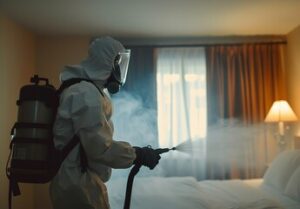Bed bug infestations are common in hotels, apartment complexes, and other multi-unit housing. These nocturnal insects hide in dark cracks and crevices during the day.

The best way to control bed bugs is with preventive measures, such as encasing mattresses and box springs and using interceptors. When these measures fail, professional chemical treatment by a registered pest controller is often required. Get in touch with Bed Bug Control Boise for professional support.
Mattress encasements are an excellent proactive tool for bed bug prevention. They work by completely encapsulating mattresses and box springs in an impermeable barrier, which prevents the bugs from hiding in crevices and seams on the beds, as well as the nooks and crannies of the bed frame itself. This helps to limit the spread of these pests and makes them much easier to deal with once they are found in a facility. However, it’s important to remember that encasements are not a stand-alone solution and should be used in conjunction with other control methods.
When choosing an encasement, be sure it is a product labeled as “bed bug proof” or that it has been scientifically tested to prove effective against these insects. Additionally, make sure the encasement fits snugly and has no tears or openings where bed bugs might escape. Also, be sure to purchase an encasement that is designed to fit both the mattress and box spring since they are usually different sizes.
Once the encasement is in place, it should not be removed. Instead, it should be laundered regularly and inspected for any rips or holes that might allow the insects to escape. It is also recommended that the encasement be inspected regularly to make sure it is still functioning properly.
In addition to encasements, mattress liners are another effective prevention method for bed bugs. While they are not a complete solution on their own, they can be a helpful way to help prevent the spread of bed bugs in facilities that have experienced infestations in the past. These liners are typically placed between the mattress and the sheet, and they prevent the bed bugs from spreading to other surfaces and areas of the room.
When using liners and encasements in your facility, be sure to double bag all personal items (toys, papers, books, electronics, etc.) in clear plastic bags to help prevent the transfer of bed bugs between personal items and the facility. It’s also a good idea to keep in mind that these products only provide limited protection against bed bugs, so they should be used alongside other control measures, such as interceptors and vaporizing treatments.
Interceptors
Bed Bug interceptor traps are one of the most popular and effective methods for detecting and monitoring bed bug infestations. These traps are placed under the legs of furniture, like beds and sofas, and they act as a barrier that bed bugs cannot cross to reach their host. They can also be used in conjunction with other treatment methods, such as sprays and vacuuming.
Bed bug interceptors are typically made from a double-walled plastic container with an inner pitfall that is slick and coated in talcum powder (or, in some cases, dry ice). When a bed bug crawls into the trap, it will be unable to climb out. This is because the inner walls of the trap are much steeper than the outer ones.
Generally, interceptors are placed under the legs of infested furniture, and they are especially useful for catching bed bugs between professional pest control services. For the best results, it’s important to place enough interceptor traps in a room to adequately monitor the area. A good rule of thumb is to place one interceptor per bedroom, plus a few more under other furniture, like nightstands and sofas.
Interceptors are also a great option for homes with children or pets, as they are completely chemical-free. This makes them an excellent choice for those who are sensitive to chemicals and prefer a more natural approach to bed bug control.
Another advantage of interceptors is that they are easy to set up and maintain. Just be sure to check the traps regularly and to replace any that are full or damaged. Additionally, it’s a good idea to dust the traps on a regular basis, as this will help keep them slick and slippery.
Despite their ease of use, interceptors should not be considered an ultimate solution to a bed bug problem. Rather, they should be used in combination with other treatments, such as sprays and professional bed bug control services. This will ensure that the entire infestation is treated and eliminated, not just the bugs that are visible to the naked eye.
Vacuuming
Vacuuming is a part of many bed bug treatment services, but it doesn’t kill all the bugs. It helps remove bugs and their eggs from surfaces, which makes it easier to treat them with pesticides or other methods of killing the insects. It also reduces allergens from the pests’ feces and skin, which can be a source of discomfort for people with allergies.
Vacuming is a good preventive measure, especially in hotels and other places where people are likely to sleep. Vacuum cleaners with a HEPA filter can be a good choice, as they will keep the allergens from becoming airborne while vacuuming. A crevice tool is ideal for removing clumps of bugs and eggs from hard-to-reach spots, such as corners, edges, seams, cracks, or creases. When using a vacuum for Bed Bug Control, it is important to change out the vacuum bag frequently, so the insects don’t escape into other areas of the house. The vacuum cleaner should be dedicated to this task and not used for anything else. It is also a good idea to place tape over the nozzle between vacuuming sessions.
The best way to get rid of bed bugs is to use a professional pest control company. The service will use a holistic approach and expertly tailored treatment plans to target the infestation at all stages of life. This will include a combination of treatments, such as insecticides and heat, as well as preventive measures such as mattress covers, vacuuming, and washing linens in hot water.
HiCare is a leading provider of pest control services, including expert Bed Bug Control. With a team of highly qualified and experienced technicians, the company has a proven track record for customer satisfaction and safety. It also uses eco-friendly products and tailors its treatments to suit specific needs. Its services are competitively priced and can be delivered in a timely manner. Call today to book an appointment!
Heat Treatment
A bed bug heat treatment is a great option for those with heavy infestations and who want a quick and effective solution. The process involves the use of specialized equipment that can raise room temperatures to levels high enough to kill the pests and their eggs. However, the process requires careful preparation to ensure that all areas of the home are covered. It also takes some time for the room to return to normal, but it is usually the most effective treatment option available for killing bed bugs.
It’s important to note that heat treatments can be dangerous and are best left in the hands of a professional. Only a pest control company with the proper training and experience can safely and effectively use this type of equipment to treat a dwelling.
During the treatment, rooms are heated to about 140 degrees Fahrenheit which is high enough to kill the bugs. The treatment can be carried out in an entire dwelling or targeted in specific rooms. Infested furniture and other belongings are moved out of the way while the heat is applied. This allows the technician to more easily reach infested cracks and crevices where the pests like to hide.
Heavily infested beds should be encased in a mattress and box spring encasement before treatment begins. This will help to keep the heat from reaching other parts of the bed where the bugs are not located. If heavy infestations are present, it’s a good idea to also encase couches and other larger furniture in similar encasements.
Vacuuming the home is also a necessary step prior to a heat treatment. This should be done to remove as many of the pests as possible before they are exposed to the hot temperatures of the treatment. It’s also a good idea to vacuum any areas that are normally obscured by furniture and seal any cracks where the insects may be hiding during the day.
It’s also a good idea to consider using other tools like interceptors and mattress and box spring encasements prior to a heat treatment as well. These additional measures will improve the chances that all the bugs in a home are killed during the treatment and prevent the problem from returning once it is complete.

